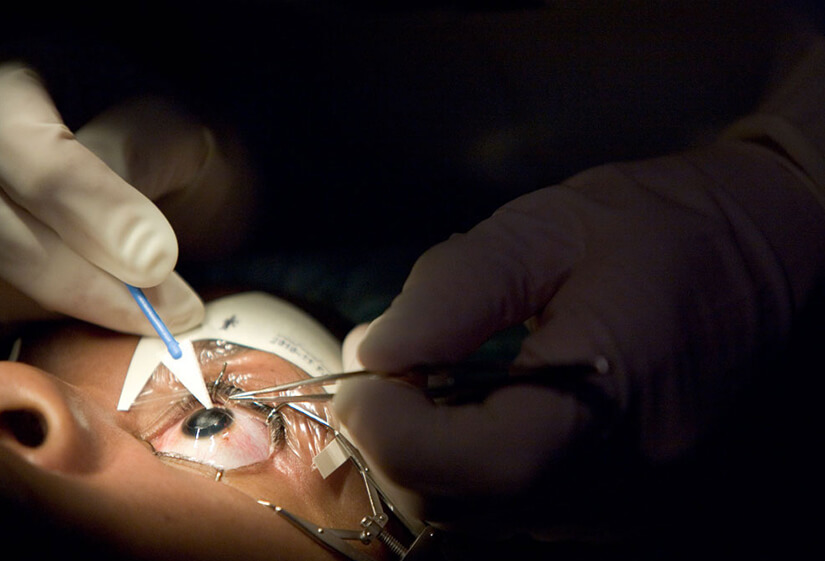Introduction:
In our world, where clear vision is crucial for day-to-day activities, eye conditions and vision impairments can pose a significant hindrance. However, thanks to remarkable medical advancements, a revolutionary procedure has emerged, transforming the lives of millions by restoring their vision. This article delves into the realm of laser eye treatment, offering a comprehensive understanding of the procedure, its benefits, and dispelling myths. Moreover, it sheds light on the promising future that this groundbreaking technology holds.
Understanding Eye Conditions:
Before delving into this eye treatment, it is essential to comprehend the common eye problems that affect individuals worldwide. Conditions such as nearsightedness, farsightedness, and astigmatism can impact daily life, making tasks like reading, driving, and recognizing faces challenging.

The Impact of Vision Impairment:
Vision impairment can significantly affect one’s quality of life. From reduced productivity at work to limitations in leisure activities, individuals with eye conditions often experience a lower quality of life. This highlights the importance of seeking effective treatments like laser eye treatment to restore clear vision and regain independence.
The Emergence of Laser Eye Treatment:
What is Laser Eye Treatment?
Laser eye treatment, also known as LASIK (Laser-Assisted In Situ Keratomileusis), is a popular surgical procedure designed to correct refractive errors in the eye. During the surgery, a laser is used to reshape the cornea, enabling light to focus correctly on the retina, thereby improving vision.
Types of Laser Eye Treatments:
There are various types of treatments available, including PRK (Photorefractive Keratectomy) and LASIK (Laser-Assisted Sub-Epithelial Keratectomy). Each treatment option is tailored to suit different eye conditions and patient needs.
Advantages of Laser Eye Treatment:
This treatment offers numerous benefits over traditional vision correction methods, such as eyeglasses or contact lenses. Some advantages include reduced dependency on visual aids, rapid recovery, and improved visual acuity.
The Procedure: Step by Step:
Understanding the laser eye treatment process can help alleviate any anxieties or concerns about the surgery. The procedure typically involves the following steps:
Preoperative Assessments:
Before undergoing eye treatment laser, a thorough preoperative assessment is conducted to determine the patient’s suitability for the procedure. This assessment includes evaluating the patient’s overall eye health, corneal thickness, and refractive error.
The Day of the Surgery:
On the day of the surgery, the patient is prepped for the procedure. Eye drops are administered to numb the eyes, and the area around the eyes is cleaned and sterilized.
The Laser Treatment Process:
The surgeon then uses advanced laser technology to precisely reshape the cornea, correcting the refractive error. The procedure is quick and usually painless, thanks to the numbing eye drops.
Recovery and Postoperative Care:
Following the surgery, patients are given specific postoperative instructions to ensure a smooth recovery. The eyes may be sensitive initially, but most individuals experience significant improvements in vision within a few days.
Who Can Benefit from Laser Eye Treatment?
Laser eye treatment can be life-changing for those who are suitable candidates. Ideal candidates for the procedure typically have stable vision and meet certain eye health criteria.
Potential Risks and Complications:
While laser eye treatment is considered safe, there are potential risks and complications associated with any surgical procedure. It’s essential for patients to be aware of these risks and discuss them thoroughly with their eye surgeon.
Debunking Common Myths:
Despite the proven effectiveness of laser eye treatment, several myths persist. Let’s debunk some of the most common misconceptions:
Myth: Laser Eye Treatment is Painful:
Contrary to popular belief, laser eye treatment is virtually painless. The procedure is performed under local anesthesia, and patients may experience mild discomfort, if any, during the recovery period.
Myth: Laser Eye Treatment is Not Permanent:
Laser eye treatment provides long-lasting results. While vision may change naturally with age, the effects of the surgery are generally permanent.
Myth: Everyone is a Suitable Candidate:
While many individuals can benefit from this treatment, not everyone is a suitable candidate. Factors such as age, overall eye health, and refractive error play a crucial role in determining eligibility.
Life After Laser Eye Treatment:
Immediate Improvements:
The majority of patients experience immediate improvements in their vision following laser eye surgery. Activities like reading, driving, and using digital devices become more manageable without the need for glasses or contacts.
Long-term Benefits:
Aside from the initial improvements, eye treatment offers long-term benefits. The reduced dependency on visual aids and improved clarity enhance the overall quality of life.
Post-Treatment Precautions:
The healthcare providers advise patients to ensure optimal results by actively following post-treatment precautions, which involve refraining from rubbing their eyes and attending all scheduled follow-up appointments.
The Advancements in Laser Eye Technology:
Laser eye technology continues to evolve, leading to increasingly sophisticated operation options.
Wavefront Technology:
Wavefront technology allows for a personalized treatment plan, addressing unique imperfections in each patient’s eyes for enhanced accuracy.
Femtosecond Lasers:
Femtosecond lasers offer greater precision in corneal reshaping, minimizing the risk of complications.
Personalized Treatments:
Advancements in technology enable personalized treatments that cater to each patient’s specific needs, maximizing the chances of success.
Considering the Cost and Affordability:
Factors Influencing the Cost:
The cost of laser eye treatment can vary depending on several factors, including the type of procedure, the surgeon’s experience, and the location of the eye treatment center.
The Investment in Clear Vision:
This may represent a significant financial investment, many patients find it to be a worthwhile expense when considering the long-term benefits and improved quality of life.
Choosing the Right Eye Treatment Center:
Research and Credentials:
Selecting a reputable eye treatment center is crucial for a successful outcome. Advisers advise patients to research the credentials and experience of potential surgeons and clinics.
Patient Reviews and Testimonials:
Reading patient reviews and testimonials can provide valuable insights into the experiences of others who have undergone laser eye surgery at a particular center.
The Future of Laser Eye Treatment:
As technology continues to advance, the future of this treatment looks promising.
Ongoing Research and Innovations:
Ongoing research in the field of ophthalmology aims to further refine and improve laser eye treatment, enhancing outcomes for patients.
Expanding Accessibility:
As the procedure becomes more refined and accessible, laser eye is likely to reach a broader audience, benefiting even more individuals with vision impairments.
Conclusion:
Laser eye surgery has revolutionized the way we address vision impairments, offering a safe and effective solution for individuals seeking to improve their quality of life. With its numerous advantages and continuous advancements, this eye treatment is a beacon of hope for those dreaming of a life with clear vision.
FAQs:
- Laser eye surgery pain full ? Laser eye treatment is generally not painful as skilled ophthalmologists perform the procedure under local anesthesia. During the recovery period, patients may experience mild discomfort, but overall, the level of pain is minimal.
- How long does the procedure take? The actual laser treatment typically takes just a few minutes per eye. Including preoperative preparations and postoperative recovery, the entire process may take a few hours.
- Can I undergo laser eye treatment if I have astigmatism? Yes, laser eye surgery can effectively correct astigmatism along with other refractive errors.
- What are the potential risks involved? While rare, treatment poses potential risks, including infection, dry eyes, and temporary vision disturbances.
- It’s essential to discuss these risks with your eye surgeon before the procedure.
- Is there an age limit for laser eye treatment? There is no strict age limit for treatment, but candidates should have stable vision and meet the necessary health criteria for the procedure.













